suspension MITSUBISHI LANCER 2005 Service Manual
[x] Cancel search | Manufacturer: MITSUBISHI, Model Year: 2005, Model line: LANCER, Model: MITSUBISHI LANCER 2005Pages: 788, PDF Size: 45.98 MB
Page 219 of 788
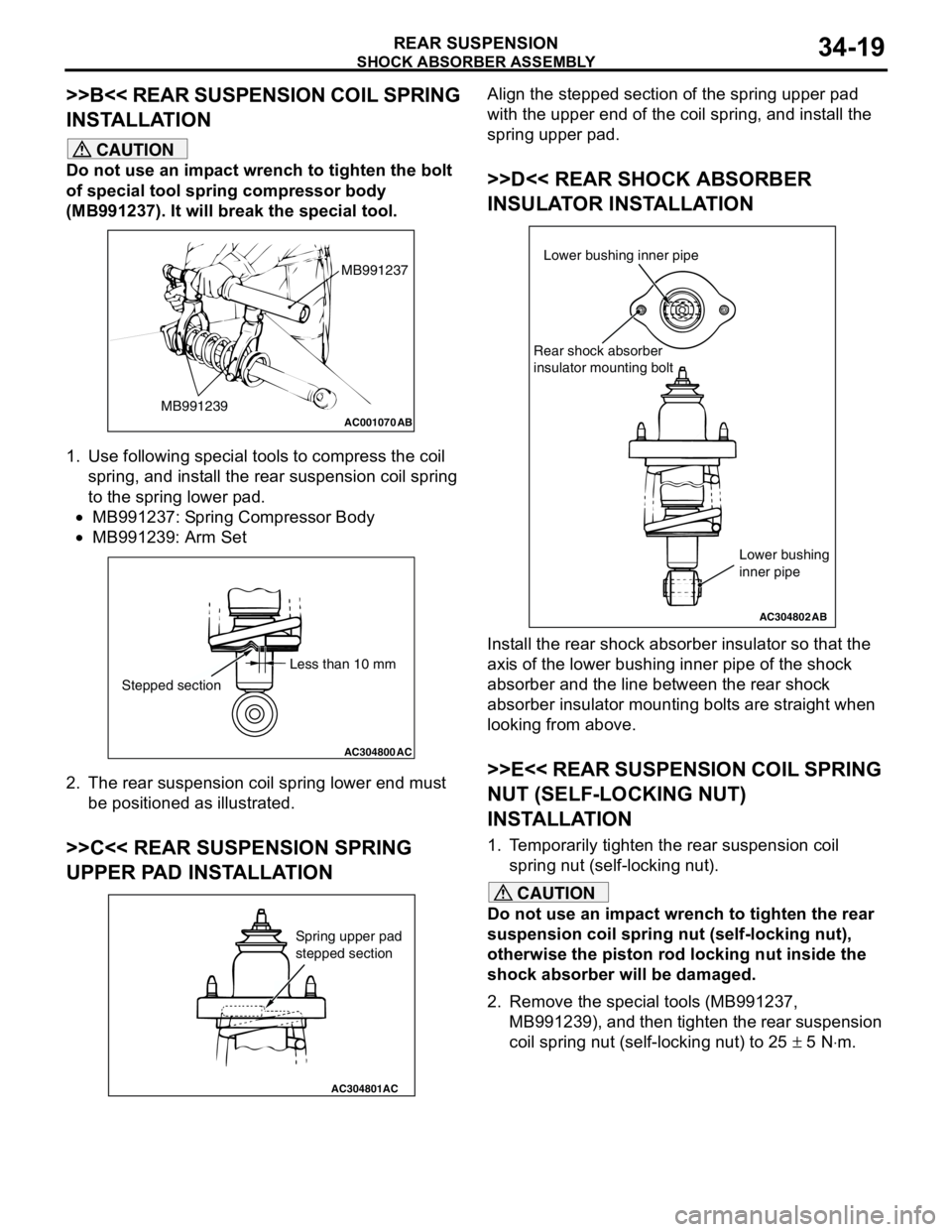
SHOCK ABSORBER ASSEMBLY
REAR SUSPENSION34-19
>>B<< REAR SUSPENSION COIL SPRING
INSTALLATION
CAUTION
Do not use an impact wrench to tighten the bolt
of special tool spring compressor body
(MB991237). It will break the special tool.
1. Use following special tools to compress the coil
spring, and install the rear suspension coil spring
to the spring lower pad.
•MB991237: Spring Compressor Body
•MB991239: Arm Set
2. The rear suspension coil spring lower end must
be positioned as illustrated.
>>C<< REAR SUSPENSION SPRING
UPPER PAD INSTALLATION
Align the stepped section of the spring upper pad
with the upper end of the coil spring, and install the
spring upper pad.
>>D<< REAR SHOCK ABSORBER
INSULATOR INSTALLATION
Install the rear shock absorber insulator so that the
axis of the lower bushing inner pipe of the shock
absorber and the line between the rear shock
absorber insulator mounting bolts are straight when
looking from above.
>>E<< REAR SUSPENSION COIL SPRING
NUT (SELF-LOCKING NUT)
INSTALLATION
1. Temporarily tighten the rear suspension coil
spring nut (self-locking nut).
CAUTION
Do not use an impact wrench to tighten the rear
suspension coil spring nut (self-locking nut),
otherwise the piston rod locking nut inside the
shock absorber will be damaged.
2. Remove the special tools (MB991237,
MB991239), and then tighten the rear suspension
coil spring nut (self-locking nut) to 25 ± 5 N⋅m.
AC001070
MB991237
MB991239
AB
AC304800AC
Less than 10 mm
Stepped section
AC304801AC
Spring upper pad
stepped section
AC304802
Lower bushing inner pipe
Rear shock absorber
insulator mounting bolt
AB
Lower bushing
inner pipe
Page 220 of 788
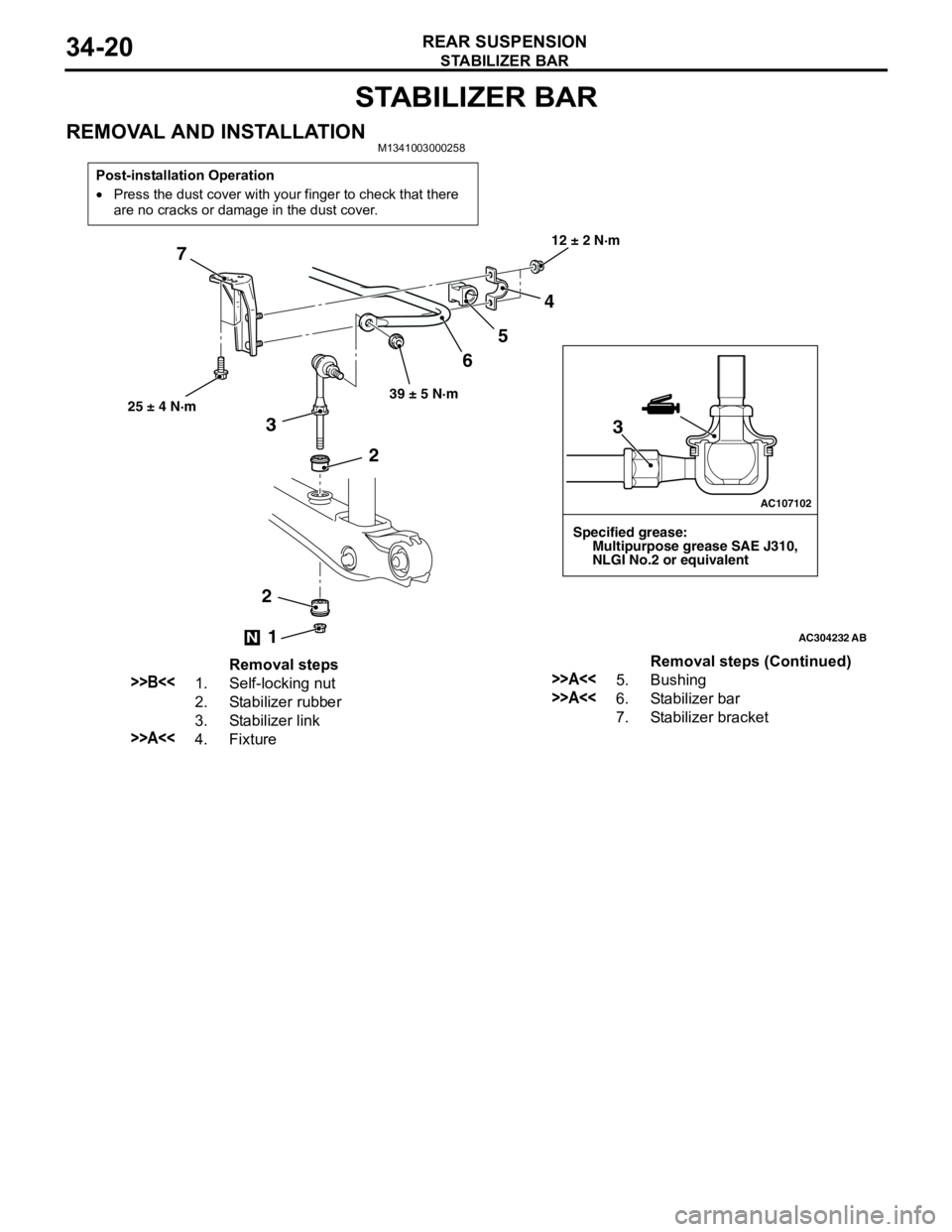
STABILIZER BAR
REAR SUSPENSION34-20
STABILIZER BAR
REMOVAL AND INSTALLATIONM1341003000258
Post-installation Operation
•Press the dust cover with your finger to check that there
are no cracks or damage in the dust cover.
AC304232
AC107102
AB
12 ± 2 N·m
39 ± 5 N·m
4
5
6 7
25 ± 4 N·m
Specified grease:
Multipurpose grease SAE J310,
NLGI No.2 or equivalent
2
2
3
1N
3
Removal steps
>>B<<1. Self-locking nut
2. Stabilizer rubber
3. Stabilizer link
>>A<<4. Fixture
>>A<<5. Bushing
>>A<<6. Stabilizer bar
7. Stabilizer bracketRemoval steps (Continued)
Page 221 of 788
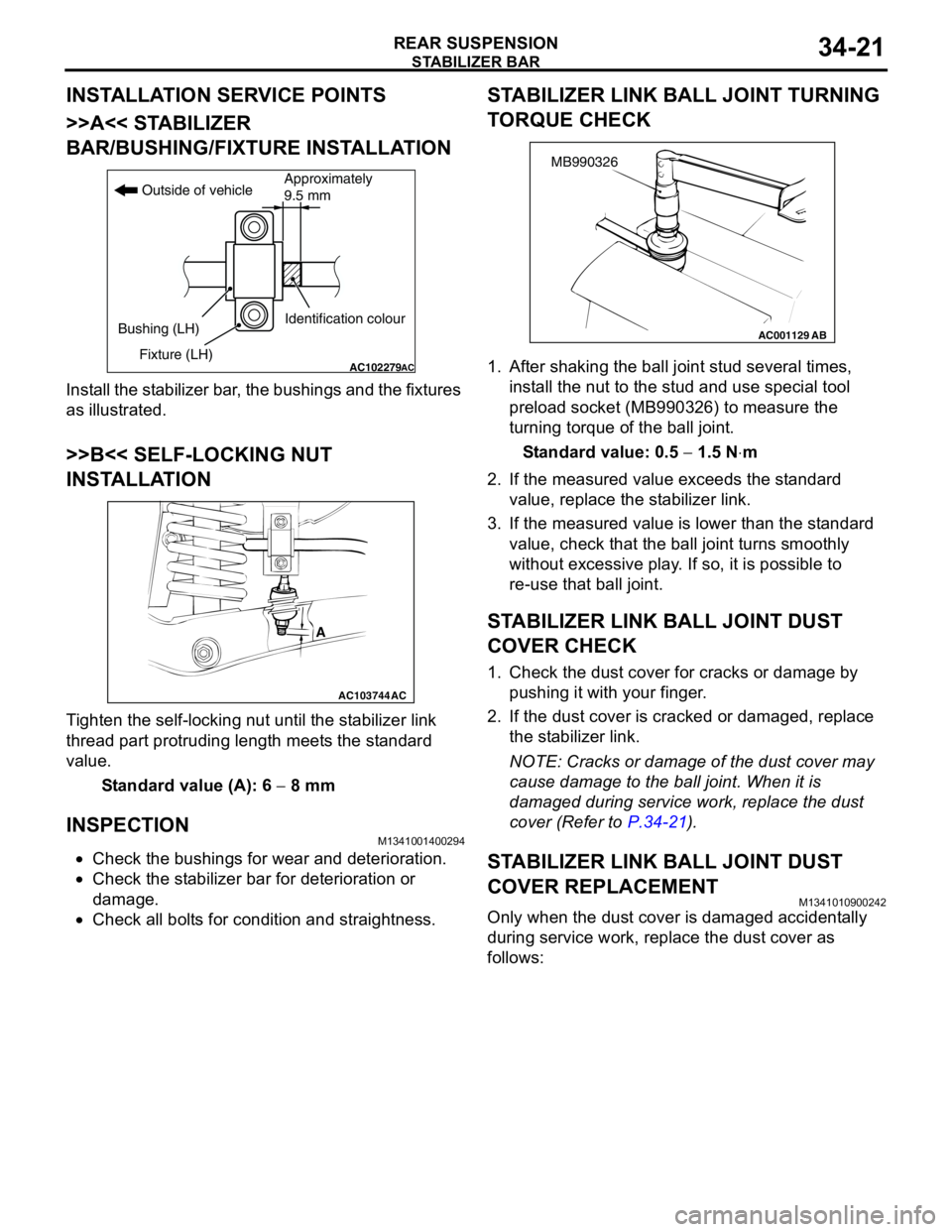
STABILIZER BAR
REAR SUSPENSION34-21
INSTALLATION SERVICE POINTS
>>A<< STABILIZER
BAR/BUSHING/FIXTURE INSTALLATION
Install the stabilizer bar, the bushings and the fixtures
as illustrated.
>>B<< SELF-LOCKING NUT
INSTALLATION
Tighten the self-locking nut until the stabilizer link
thread part protruding length meets the standard
value.
Standard value (A): 6 − 8 mm
INSPECTIONM1341001400294
•Check the bushings for wear and deterioration.
•Check the stabilizer bar for deterioration or
damage.
•Check all bolts for condition and straightness.
STABILIZER LINK BALL JOINT TURNING
TORQUE CHECK
1. After shaking the ball joint stud several times,
install the nut to the stud and use special tool
preload socket (MB990326) to measure the
turning torque of the ball joint.
Standard value: 0.5 − 1.5 N⋅m
2. If the measured value exceeds the standard
value, replace the stabilizer link.
3. If the measured value is lower than the standard
value, check that the ball joint turns smoothly
without excessive play. If so, it is possible to
re-use that ball joint.
STABILIZER LINK BALL JOINT DUST
COVER CHECK
1. Check the dust cover for cracks or damage by
pushing it with your finger.
2. If the dust cover is cracked or damaged, replace
the stabilizer link.
NOTE: Cracks or damage of the dust cover may
cause damage to the ball joint. When it is
damaged during service work, replace the dust
cover (Refer to P.34-21).
STABILIZER LINK BALL JOINT DUST
COVER REPLACEMENT
M1341010900242
Only when the dust cover is damaged accidentally
during service work, replace the dust cover as
follows:
AC102279AC
Outside of vehicle
Bushing (LH)
Fixture (LH)Identification colourApproximately
9.5 mm
AC103744
A
AC
AC001129
MB990326
AB
Page 222 of 788
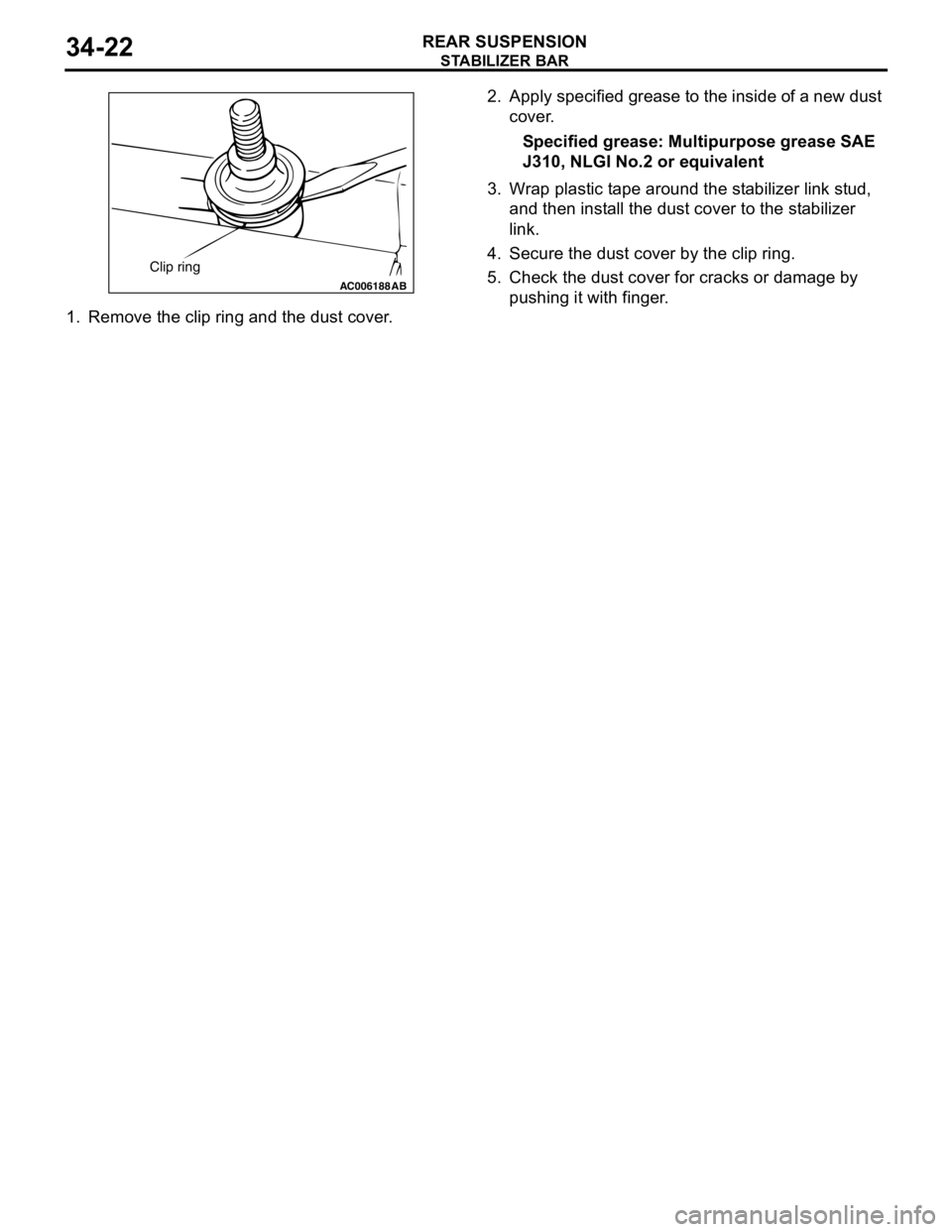
STABILIZER BAR
REAR SUSPENSION34-22
1. Remove the clip ring and the dust cover.2. Apply specified grease to the inside of a new dust
cover.
Specified grease: Multipurpose grease SAE
J310, NLGI No.2 or equivalent
3. Wrap plastic tape around the stabilizer link stud,
and then install the dust cover to the stabilizer
link.
4. Secure the dust cover by the clip ring.
5. Check the dust cover for cracks or damage by
pushing it with finger.
AC006188 AB
Clip ring
Page 454 of 788
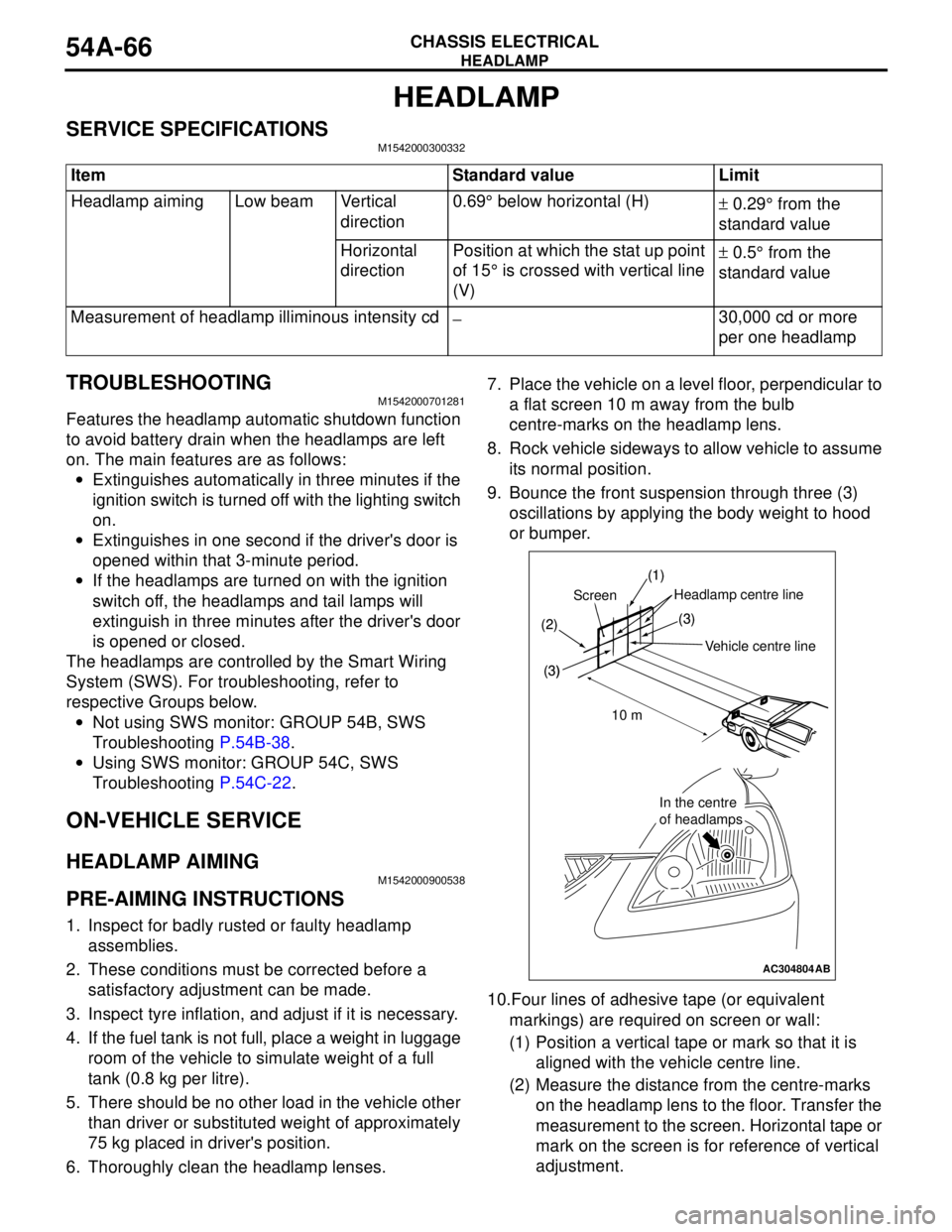
HEADLAMP
CHASSIS ELECTRICAL54A-66
HEADLAMP
SERVICE SPECIFICATIONSM1542000300332
TROUBLESHOOTING M1542000701281
Features the headlamp automatic shutdown function
to avoid battery drain when the headlamps are left
on. The main features are as follows:
•Extinguishes automatically in three minutes if the
ignition switch is turned off with the lighting switch
on.
•Extinguishes in one second if the driver's door is
opened within that 3-minute period.
•If the headlamps are turned on with the ignition
switch off, the headlamps and tail lamps will
extinguish in three minutes after the driver's door
is opened or closed.
The headlamps are controlled by the Smart Wiring
System (SWS). For troubleshooting, refer to
respective Groups below.
•Not using SWS monitor: GROUP 54B, SWS
Troubleshooting P.54B-38.
•Using SWS monitor: GROUP 54C, SWS
Troubleshooting P.54C-22.
ON-VEHICLE SERVICE
HEADLAMP AIMING
M1542000900538
PRE-AIMING INSTRUCTIONS
1. Inspect for badly rusted or faulty headlamp
assemblies.
2. These conditions must be corrected before a
satisfactory adjustment can be made.
3. Inspect tyre inflation, and adjust if it is necessary.
4. If the fuel tank is not full, place a weight in luggage
room of the vehicle to simulate weight of a full
tank (0.8 kg per litre).
5. There should be no other load in the vehicle other
than driver or substituted weight of approximately
75 kg placed in driver's position.
6. Thoroughly clean the headlamp lenses.7. Place the vehicle on a level floor, perpendicular to
a flat screen 10 m away from the bulb
centre-marks on the headlamp lens.
8. Rock vehicle sideways to allow vehicle to assume
its normal position.
9. Bounce the front suspension through three (3)
oscillations by applying the body weight to hood
or bumper.
10.Four lines of adhesive tape (or equivalent
markings) are required on screen or wall:
(1) Position a vertical tape or mark so that it is
aligned with the vehicle centre line.
(2) Measure the distance from the centre-marks
on the headlamp lens to the floor. Transfer the
measurement to the screen. Horizontal tape or
mark on the screen is for reference of vertical
adjustment. Item Standard value Limit
Headlamp aiming Low beam Vertical
direction0.69° below horizontal (H)
± 0.29° from the
standard value
Horizontal
directionPosition at which the stat up point
of 15° is crossed with vertical line
(V)± 0.5° from the
standard value
Measurement of headlamp illiminous intensity cd
−30,000 cd or more
per one headlamp
AC304804
(1)
(2)
(3)
Headlamp centre line
Vehicle crntre line Screen
(3)
10 m
In the centre
of headlamps
(1)
(2)
(3)(3)
In the centre
of headlamps
AB
Vehicle centre line
ScreenHeadlamp centre line
10 m